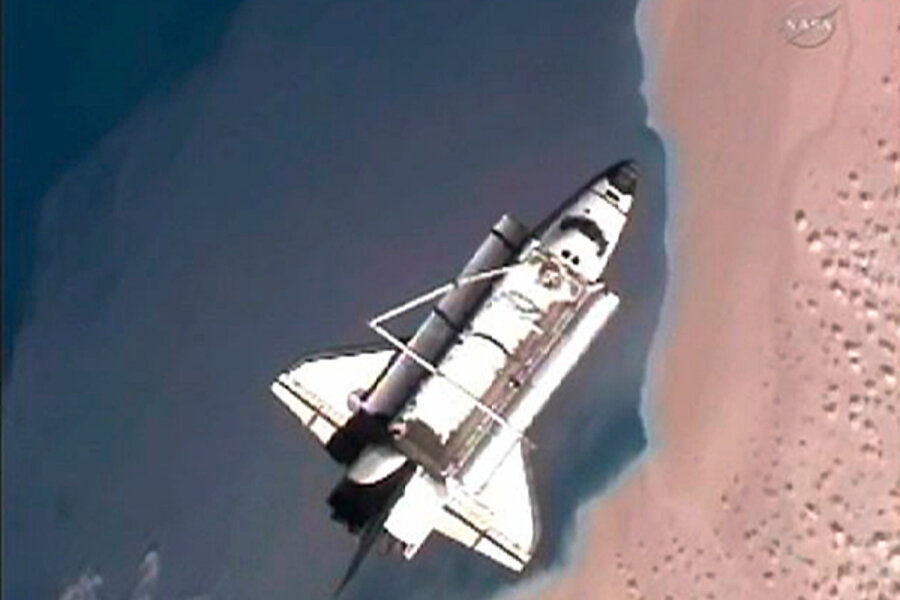Space shuttle Discovery wraps up mission that went 'above and beyond'
Loading...
If all goes well and the space shuttle Discovery and its six-member crew return safely to Earth on Wednesday, the orbiter's final trip may well go down as the program's "above and beyond" mission.
That's the bumper-sticker phrase given the mission by Kenneth Todd, who heads the International Space Station's mission management team, during a briefing for reporters on Monday.
Not only did the craft and crew meet the mission's main goals – delivering cargo, a new pressurized storage module, an outside storage platform, a robot-astronaut prototype, and tons of cargo.
Spacewalks and indoor tasks were performed so quickly and efficiently that managers added two days to Discovery's docked time at the space station to help the station crew get ahead on some jobs that would otherwise have fallen to space-station crew members.
Typically, "we don't do docked missions and add a couple of extra days," he said.
"Every one of these missions tend to take on their own character," Mr. Todd said. On this mission, "we had some bumps along the way."
Indeed, the launch was delayed for several months as engineers tackled a problem with Discovery's external fuel tank.
But once the shuttle and crew were in space, the orbiter's systems performed so well that "nothing threatened to change the mission profile" or the objectives the mission aimed to accomplish, Todd said.
Too fast for Houston
This git-'er-done mentality carried over into tasks the shuttle crew performed after leaving the space station.
At one point, shuttle commander Steven Lindsey was preparing a key component of the shuttle's navigation system for the return home. Apparently he managed to get a step or two ahead of controllers in Houston trying to choreograph the procedure.
"Discovery? You are 'go' for what you just did," came the comment from mission control, with a barely masked chuckle.
"Sounds a lot better than 'no go' for what I just did," Lindsey shot back.
The crew spent much of the day conducting a final inspection of the orbiter's thermal-protection system – a procedure that became a regular part of shuttle operations after the Columbia disaster in 2003. That orbiter broke up on reentry after insulating foam from the external fuel tank broke free on liftoff and struck the leading edge of one of the shuttle's wings. The damage allowed searingly hot gases to destroy control systems inside the wing.
[Editor's note: The original version misstated the name of the shuttle that broke up in 2003.]
On Tuesday, Discovery's crew will prepare the orbiter for reentry, with touchdown at the Kennedy Space Center slated for 11:57 a.m. Wednesday morning, Eastern Standard Time.
Discovery's final mission leaves as many as two additional shuttle flights before the program ends. Endeavour, currently slated to launch no earlier than April 19, makes its final trip to the launch pad Wednesday night. NASA has scheduled a final flight for Atlantis in late June.
Human spaceflight
While much has been made of each orbiter's final trip, the impact of the shuttle program's end on the people who work with them took the spotlight Monday. When flight director Bryan Lunney's shift ended, he left the flight director's console in mission control for the last time – to a standing ovation from his team and words of appreciation from Discovery's crew.
Mr. Lunney – who joined the agency out of college in 1988, and has been involved with some 50 shuttle missions – essentially picked up where his father, Apollo flight director Glynn Lunney, left off.
Now, it's off to the private sector and aerospace companies, which have a stake both in the future of NASA's human-spaceflight program as well as the future of commercial companies vying to fly humans and cargo to the space station.
Like many involved with the shuttle program, Lunney says Discovery's curtain call is bittersweet.
The orbiters NASA operated represented "tools" that evolved with time and experience, allowing astronauts to take on longer, more complex missions – although the Challenger and Columbia disasters taught some hard lessons, he acknowledged.
Because of those lessons, "that's why Discovery today is in such great shape," he said.
When asked for his sense of the shuttle program's 30-year legacy, he said, "generations of people have evolved this vehicle to be able to do some amazing things. I think we're going to look back at it and just go: Wow! It's been unparalleled in the history of mankind what we've been able to do with that shuttle."





